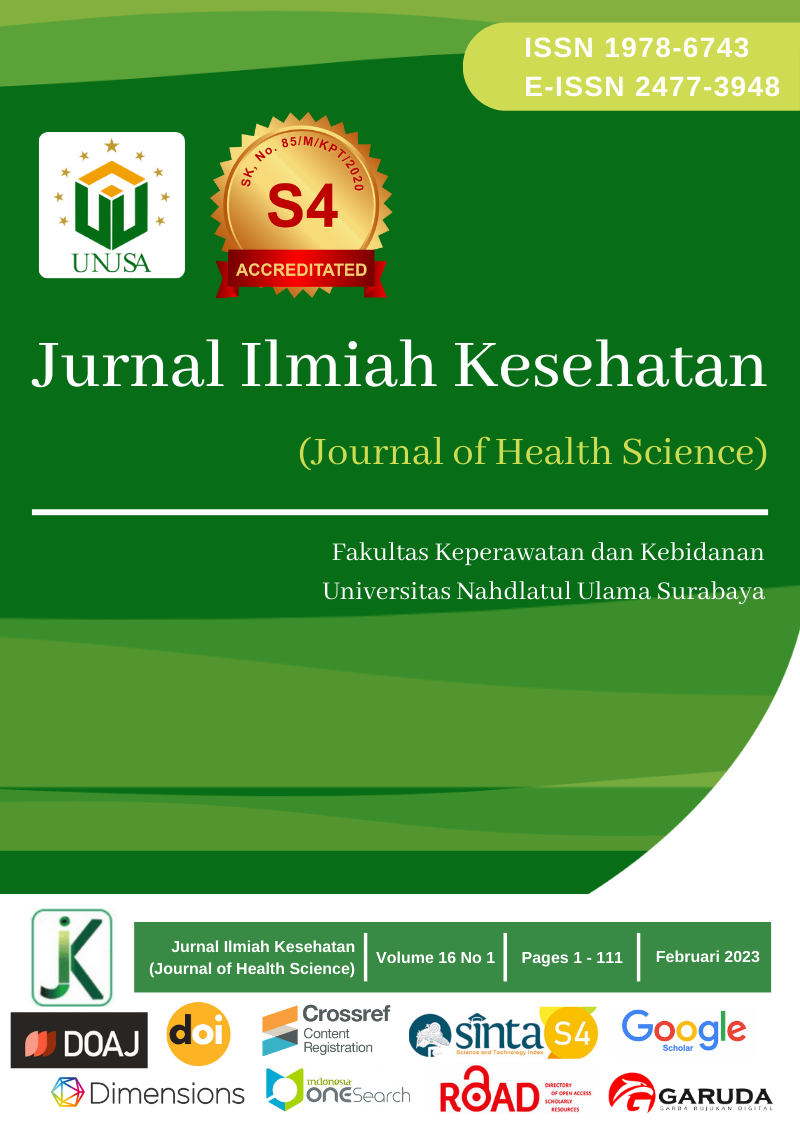Analysis Factors of Motivation Among Adolescents in 3M Behavior During the Covid-19 Pandemic
Main Article Content
Abstract
Confirmed cases of COVID-19 in the adolescent are currently still happened. There needs to be motivation from teenagers to carry out 3M behavior to prevent the transmission of COVID-19, especially in the adolescent. This study aimed to identify factors related to adolescent motivation in carrying out 3M behavior during the COVID-19 pandemic. This study was conducted with a cross-sectional design of 427 adolescents in Palembang. The school sample was obtained using a random method, and respondents' determination was carried out purposively according to research inclusion criteria. Multiple linear regression analysis results showed that age, gender, education level, autonomy, policies, nurse support, and family support influenced adolescent motivation in carrying out 3M behavior during the pandemic (p = 0.000; 1 = 0.417; R2 = 0.651). The family support factor is the most influencing factor for adolescent motivation in carrying out 3M behavior during the COVID-19 pandemic (p = 0.000, 1 = 0.360) after being controlled by other variables (age, gender, education level, autonomy, policies, and nurse support). Knew the dominant factors is family suppot could increase health promotion program in an adolescent during the COVID-19 pandemic.
Downloads
Article Details
Copyright (c) 2022 Nurma Zela Gustina, Widyatuti Widyatuti, Musparlin Halid

This work is licensed under a Creative Commons Attribution-ShareAlike 4.0 International License.
References
Campbell, K., Weingart, R., & Ashta, J. (2021). COVID-19 Knowledge and Behavior Change among High School Students in Georgia, Semi-rural. Journal OfSchool Health, 91(7). https://doi.org/10.1111/josh.13029
Covid-19 Satgas. (2020a). Data Sebaran Covid-19.
Covid-19 Satgas. (2020b). Pedoman perubahan perilaku.
Götzinger, F., Santiago-garcía, B., Noguera-julián, A., Lanaspa, M., Lancella, L., & Carducci, F. I. C. (2020). Articles COVID-19 in children and adolescents in Europe : a multinational , multicentre cohort study. Lancet Child Adolesc Health, 653–661. https://doi.org/10.1016/S2352-4642(20)30177-2
Halty, L., Halty, A., & Gregorio, V. C. De. (2021). Support for Families During COVID ‑ 19 in Spain : The iCygnus Online Tool for Parents. Child Psychiatry & Human Development, 0123456789. https://doi.org/10.1007/s10578-021-01172-z
Howard, C. (2020). Nursing and Health Policy Perspectives Nursing in the COVID-19 pandemic and beyond : protecting , saving , supporting and honouring nurses. International Council of Nurses, 157–159. https://doi.org/10.1111/inr.12593
Kemenkes. (2020). Pencegahan, Pedoman Pengendalian, dan Pengendalian COVID-19.
Luo, Y., Yao, L., Zhou, L., Yuan, F., & Zhong, X. (2020). Factors in fl uencing health behaviours during the coronavirus disease 2019 outbreak in China : an extended information-motivation- behaviour skills model. Public Health, 185(June), 298–305. https://doi.org/10.1016/j.puhe.2020.06.057
Nies, M. A., & Mcewen, M. (2015). Community / Public Health Nursing Promoting the Health of Populations (SIXTH EDIT). Elsevier Health Sciences.
Oosterhoff, B., Palmer, C. A., & Wilson, J. (2020). Adolescents ’ Motivations to Engage in Social Distancing During the COVID-19 Pandemic : Associations With Mental and Social Health. Journal of Adolescent Health, 67(2), 179–185. https://doi.org/10.1016/j.jadohealth.2020.05.004
Pender, N. J., & Murdaugh, C. L. (2015). Health Promotion in Nursing Practice (Seventh). Pearson Education Inc.
Rad, R. E., Mohseni, S., Takhti, H. K., & Azad, M. H. (2021). Application of the protection motivation theory for predicting COVID-19 preventive behaviors in Hormozgan , Iran : a cross- sectional study. BMC Public Health, 21, 1–12.
Rizqi, W. A. (2017). Pengaruh Lingkungan Pendidikan Terhadap Motivasi Belajar Ssiwi Kes X di MA NU Banat Kudus 2017. Uin Walisongo.
Sakdiyah, E. H. (2013). Dimensi perilaku promosi kesehatan remaja berdasarkan perbedaan jenis kelamin. Jurnal Psikoislamika, 10.
Schwartz, N. G., Moorman, A. C., Makaretz, A., Chang, K. T., & Chu, V. T. (2020). Adolescent with COVID-19 as the Source of an Outbreak at a 3-Week Family Gathering — Four States , June – July 2020. 69(40), 2019–2021.
Sun, P., & Lu, X. (2020). Understanding of COVID ‐ 19 based on current evidence. Journal of Medical Virology. https://doi.org/10.1002/jmv.25722
UNFPA. (2020). Bekerja dengan dan untuk anak muda COVID-19 : Bekerja dengan dan untuk anak muda. 1.
Wang, M., Scanlon, C. L., & Toro, J. Del. (2021). Safely Social : Promoting and Sustaining Adolescent Engagement in Social Distancing During the COVID-19 Pandemic. Journal of Adolescent Health, 1–8. https://doi.org/10.1016/j.jadohealth.2021.03.014
WHO. (2020a). Coronavirus disease 2019 (COVID-19) situation report.
WHO. (2020b). Coronavirus Disease Coronavirus Disease Situation World Health World Health Organization Organization. 19, 1–12.
WHO, E. W. (2020c). What we know about Young people and COVID-19. August.





